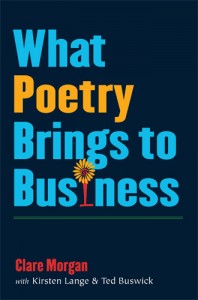For some 15 years, roughly 1996 to 2010, poet David Whyte was the missionary of poetry to business. And he was a very specific kind of missionary for poetry, as the subtitle of his book The Heart Aroused suggests: “Poetry and the Preservation of the Corporate Soul in America.” For Whyte, poetry could be not only a compass and guide for business but also something more than that, perhaps even a way to do business or preserve its soul.
In 2010, Clare Morgan, director of the graduate writing center at the university of Oxford, published What Poetry Brings to Business, coauthored with Kirsten Lange and Ted Buswick of the Boston Consulting Group. Morgan’s book doesn’t actually challenge Whyte’s for preeminence; in fact, she doesn’t even mention him or The Heart Aroused. She’s English and he’s Welsh; it might be one of those intra-Britain rivalry things (although Whyte moved to America).
Whyte used various and well known literary works, such as Beowulf, to discuss how poetry applied to the corporate soul. And The Heart Aroused is written like a poet would write it, with beautiful language and a narrative that appeals to the literary part of the mind.

And she covers her subject from about every perspective imaginable, including how poetry can help you think beyond facts; how poetry and business share major themes; how poetry can apply to business decision making; how poetry can increase business creativity; and how poetry applies to business values, like corporate social responsibility. It’s a fascinating read to see concepts and practices of poetry packaged and explained for business consumption–case studies, practical exercises, team projects, and examples of her own seminars for businesses and business groups.
Early on, Morgan comes close to Whyte when she says this: “Precision is vital to a poet, precision of language, of image, of nuance, of tone. But the indirection poetry deals in has to do with the rejection of ‘facts’ as the basis of its utterance. A poet isn’t trying to tell you something. He isn’t trying to tell you anything. The poet is taking you on a journey of exploration, and where you arrive in the end, and the nature of the journey, will be different for each person. There are no maps, no certainties.”
Much of what business is about is maps and certainties. The modern corporation was created in part to reduce uncertainty (and risk). What business has been learning for the past 30 years is that there are no certainties, and precious few maps. And poetry might suggest ways forward, or at least how to think going forward.
Both Whyte and Morgan’s approaches see poetry as something that exists outside of business, a entity separate from the day-to-day reality of business and work. Whyte would use poetry to preserve the corporate soul; Morgan would apply poetry directly to how business is done. If there is a shortcoming in both approaches, it is that neither really considers that poetry might already exist in business and work, largely ignored and unrecognized but just as vital to the ongoing operation and success of what we call work.
Photograph by Jason Samfield. Sourced via Flickr. Poetry at Work™ post by Glynn Young, author of the novels Dancing Priest and the recently published A Light Shining.
________________
Buy a year of happy work mornings today, just $5.99. In January we’re exploring the theme Coffee and Tea.
Now you can easily follow our new Poetry at Work posts. Add one of our Poetry at Work badges to your blog or website today!
- “Horace: Poet on a Volcano” by Peter Stothard - September 16, 2025
- Poets and Poems: The Three Collections of Pasquale Trozzolo - September 11, 2025
- Poets and Poems: Boris Dralyuk and “My Hollywood” - September 9, 2025


L.L. Barkat says
Love the comparisons/contrasts.
Am thinking it would be cool if you used some of Morgan’s materials with us here 🙂